
Picture this – you are a wannabe screenwriter and your first effort somehow lands on the desk of one of your favourite directors. That’s what happened for budding scribes Jim Agnew and Sean Keller when their thriller Giallo attracted the attention of Italian auteur Dario Argento, the famed creator of such renowned classics as L’uccello dalle piume di cristallo (aka The Bird With the Crystal Plumage), Profondo rosso (Deep Red) and Tenebrae. After a string of critically mauled offerings (including The Phantom of the Opera, The Card Player and Do You Like Hitchcock?), the director had finally taken a step in the right direction with La terza madre (Mother of Tears), the final part of his supernatural trilogy which had begun with Suspiria thirty years earlier. With fans hoping that he would return to his most beloved of genres, the giallo, the news finally came in January 2008 that the filmmaker was about to embark on a new murder mystery in the vein of his vintage work.
Agnew and Keller had first met whilst working in the same Hollywood bar, where they would often muse over the state of the industry and how they could make a difference if they were only given the chance. Having found work with the Sci-Fi Channel, Keller began discussing with his friend about the constant slew of ‘safe’ remakes that were flooding the market and eventually the subject moved to Italian horror. Inspired by the likes of Mario (Blood and Black Lace) Bava, Aldo (Night Train Murders) Lado and Sergio (Torso) Martino, they began to construct a script which referenced various classic elements from Argento’s work (most notably Deep Red) whilst also providing the audience with a fresh and exciting spin on the material. During the writing process, the two would constantly listen to Goblin, Argento’s music of choice, who he had collaborated with on many of his classics. With the help of a close friend, Oscar Generale (who would later handle the casting chores), the screenplay eventually found its way into the hands of one of Italy’s most prolific filmmakers.
Giallo centres on a serial killer terrorising the streets of Turin who has been dubbed as Yellow (the literal translation of the title), a deranged maniac who targets beautiful young women after being turned away by the orphanage in which he had spent his childhood. Torturing and humiliating his victims, he eventually dispatches them and sets out to find someone new, finally setting his sights on Celine, a young fashion model. Her older sister, Linda, arrives in town to visit her but becomes concerned when she does not meet her at the airport. When all else fails, she approaches a burnt-out cop, Inspector Lavia, to help track her down. When their investigations lead them to a local hospital, Linda is exposed to the killer and becomes his next intended victim, forcing Lavia into a race against time to stop him for good before it is too late.
Marking Argento’s nineteenth feature film as a director, Giallo harks back to the days of his earlier output, most notably his ‘Animal trilogy’ and Deep Red, all released in the first half of the seventies. Foregoing the usual story arch of an American or English tourist in Italy who witness a murder, Giallo still contains many of the old Argento elements, such as beautiful female victims, opera, sensationalised violence and, of course, the black gloved killer. One aspect of which not only Argento but many Italian films are criticised for is the dubbing, with many filmmakers insisting on avoiding the standard subtitle method in favour of a re-recorded audio track, and often performed by different actors. With the intention of catering to the American market, Giallo was filmed in English, despite many of the cast members struggling with their translated dialogue. The only non-English in the entire film is uttered by two Japanese girls, one of whom becomes a victim of the killer.
The casting for the movie was a somewhat troublesome affair, with indie darling Vincent Gallo originally cast as the antagonist. But when the director’s daughter, Asia Argento, was brought on board to portray Linda, the actor eventually left the project. Despite no official reason being given, it was clear that the pair’s former engagement had resulted in bad blood between them and Gallo refused to work alongside her. In his place, Byron Deidra won the role of Yellow, whilst the part of the heroine was given to Emmanuelle Seigner, wife of controversial filmmaker Roman Polanski and star of several of his films (including Frantic, Bitter Moon and The Ninth Gate). Another actor to be briefly attached to the film was Ray Liotta, who had been lined up to play Inspector Enzo Avolfi, a role which eventually went to Academy Award winner Adrien Brody (whose Oscar had been as a result of his collaboration with Polanski on The Pianist).
With Argento’s own Rome-based production company Opera Film in place, the director began to assemble an impressive crew for his latest venture. His cinematographer, Frederic Fasano, had lensed several of his more recent efforts, including Do You Like Hitchcock? and Mother of Tears, as well as Asia Argento’s directorial debut Scarlet Diva, whilst his editor, Roberto Silvi, had cut The Three Burials of Melquiades Estrada in 2005. The dramatic score was composed by Marco Werba and the grizzly effects were handled by Sergio Stivaletti, previously responsible for the blood and guts on Demons 2, Opera and Mother of Tears. Whilst his last movie had featured several gruesome set pieces, much of his recent work had been rather tame (with perhaps the exception of his Masters of Horror episodes), though Giallo promises to be as graphic as his earlier output.
With a budget of approximately $14m, principal photography commenced on May 12 2008 for a little over a month on location in Turin, the setting of many of his previous films. Post-production, meanwhile, took place in Los Angeles, with the shoot lasting until June 19. Brody was also joined by such talented actors as Elsa (Beyond Re-animator) Pataky, Robert (Donnie Brasco) Miano, Daniela (Sleepless) Fazzolari and Luis (The Card Player) Molteni. Whilst Argento has gained a reputation over the years as being difficult and stubborn, Agnew and Keller were both impressed with the filmmaker and found the collaboration an easy-going affair, with the director changing very little in the script and remaining faithful to their original vision. Brody, too, had a respect for the director and his legacy, which would result in the film avoiding the usual difficulties that Argento would experience with many of his lead actors (most notably The Bird With the Crystal Plumage‘s Tony Musante.
With Argento’s glory days seemingly long behind him, the knives always seem ready whenever he prepares to release a new movie. The cynics were out in full force when Mother of Tears was denied a proper theatrical run and was sent straight-to-video in most regions, with many critics writing him off as a has-been. Once again they wait like vultures, eager to tear apart his latest work. With very little footage currently available, it is impossible to assume what to expect from Giallo, though many have still labelled it as another forgettable effort. But Argento fans once again hold their breath and hope for something which strives for the glorious heights of Deep Red or Tenebrae. Only time will tell, as next month’s première at the Edinburgh Film Festival will finally reveal whether or not Giallo is a masterpiece or missed opportunity. For those that cannot attend, watch this space for a review.


5 Responses to SPAGHETTI SLASHERS – Giallo